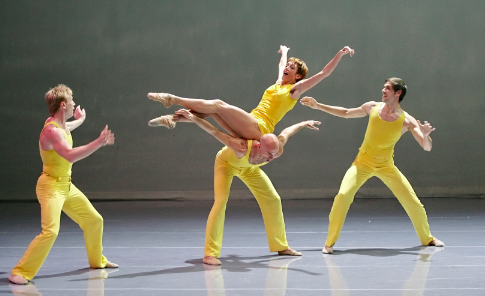![]() Guide: Modern Dance in America
Guide: Modern Dance in America
I had the pleasure of seeing Les Ballets de Monte-Carlo, the national ballet company of Monaco, perform a program of two long works, Altro Canto and Opus 40, at the Joyce Theater in New York City. Both works were created by the company’s director since the early 1990s, Jean-Christophe Maillot.
Maillot’s vocabulary is far from traditional ballet (although slippers and pointe shoes were worn by the dancers), and the dancers moved in ways that are highly unconventional: they dragged each other around the stage by the wrists, they stepped on each others backs, their limbs were sometimes extremely fluid or limp (creating an impression of passivity), and they often made extreme concave or convex shapes with their torsos (bringing to mind the contraction and release technique of Martha Graham). The movements were also often acrobatic in nature: in Altro Canto, the lead female dancer was off of the ground for several minutes, being lifted by and diving into groups forward and backward like a highly controlled crowd-surfer (one of my favorite sequences). All of this was pursued in a highly graceful manner, however, and was far from raw or violent (unlike the movement of choreographer Pina Bausch, whose work I watched just two days after this performance).

Les Ballets de Monte Carlo performing "Opus 40"
While I found this to be a compelling evening of dance that explored a range of movements and feelings in a way that felt original and sometimes unexpected, the pieces seemed to lack a cohesive structural flow. Strings of movements at times felt arbitrarily varied, and I found it difficult to detect a clear direction or an internal formal logic from moment-to-moment. At the end of a piece, I felt that I hadn’t been taken on a journey but rather spent time wandering between different facets of one place. There was a clear structural device in Opus 40: at the end of every music/dance segment, the dancers of the next segment—typically costumed in a different color scheme—would wander onto the stage, interrupting the ending of the current segment before the transition of focus occurred.
Altro Canto utilized a score of excerpted segments of Baroque music (recorded—no live music here), especially sacred music by Monteverdi, and sought to respond to the atmosphere of the music in a number of ways. Echoes often occur in the music—a solo violin line is repeated by an offstage violinist—and this was at times referred to onstage, with a duo of lead dancers downstage and and an echoing set of dancers upstage. Two singers would also sometimes be represented by two dancers, for example.

In "Altro Canto," the minimal golden lighting was intended to evoke candlelight (Maillot explained in the program that he associated candlelight with sacred music performed in cathedrals).
Generally, I felt that the dance was not always connected to or subordinated by the spirit of the music but it utilized the music when it pleased. The mood and vocabulary of the dancing did not change drastically in Opus 40, a selection of music by the avante-garde composer/vocalist Meredith Monk—stylistically extremely different from Baroque sacred music—so the dance’s connection to the music seemed to have more to do with pacing and phrasing than style.
The costuming played a large part on the visual impact of the pieces: in Altro Canto, half of both the men and women wore corsets and pants, and the other half wore tank tops and extremely poofy skirts—all gold-colored. The gender ambiguity of the costuming was intended to evoke the duality of masculine/feminine identity.
In Opus 40, the dancers were clothed in bright colors. Maillot’s program note refers to the piece as a return to childhood. While this aspect of the piece didn’t resonate with me, as the piece felt very adult and introspective, the color scheme was an effective allusion to playfulness and purity in simplicity.